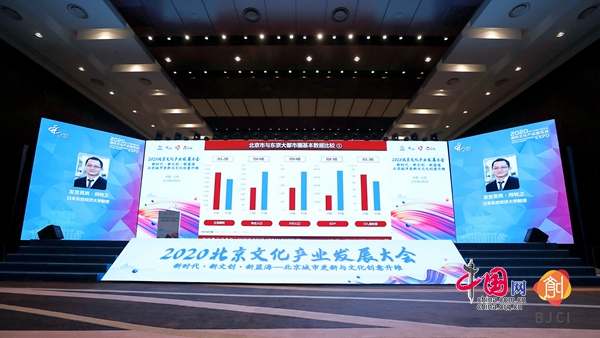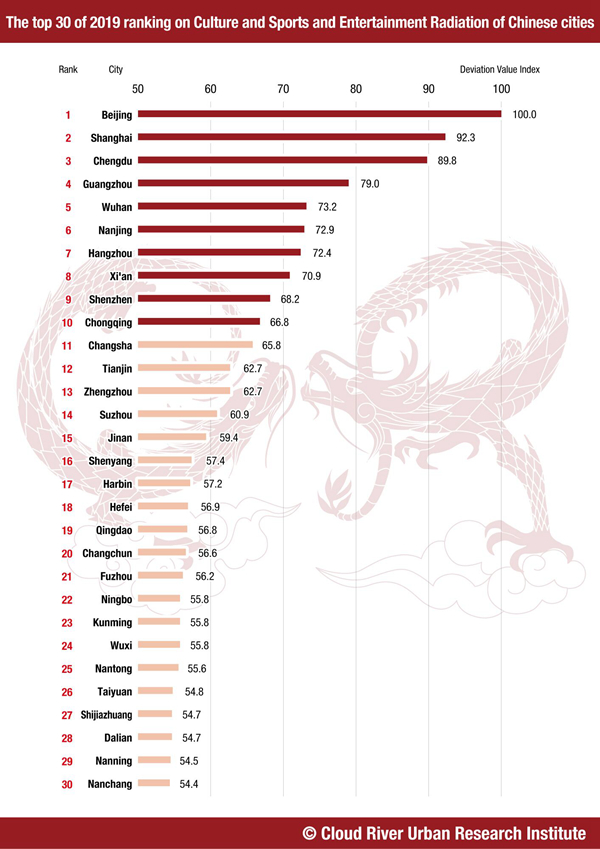A look at Beijing's cultural industry from its culture, sports and entertainment radiation
- By Zhou Muzhi
 0 Comment(s)
0 Comment(s) Print
Print E-mail China.org.cn, September 24, 2020
E-mail China.org.cn, September 24, 2020
Editor's note: The 2020 Beijing Cultural Industry Development Conference, organized by the Publicity Department of the CPC Beijing Municipal Committee, was held on Sept. 6, as part of a featured event at the 2020 China International Fair for Trade in Services (CIFTIS). Zhou Muzhi, president of Cloud River Urban Research Institute and professor of Tokyo Keizai University, delivered a keynote speech titled "A look at Beijing's cultural industry development from its culture, sports and entertainment radiation," giving his insights into the good practices and new challenges of the city's cultural industry. This article is a further elaboration on the topic based on his speech.

1. 2019 ranking on culture, sports and entertainment radiation of Chinese cities
As part of the China Integrated City Index, the Cloud River Urban Research Institute has released the 2019 ranking on culture, sports and entertainment radiation based on a research of 297 cities at prefecture level or above across China. The top 10 are Beijing, Shanghai, Chengdu, Guangzhou, Wuhan, Nanjing, Hangzhou, Xi'an, Shenzhen and Chongqing. Beijing takes an overwhelming lead in the rank.
The next 10 cities in the top 20 are Changsha, Tianjin, Zhengzhou, Suzhou, Jinan, Shenyang, Harbin, Hefei, Qingdao and Changchun. Following them, Fuzhou, Ningbo, Kunming, Wuxi, Nantong, Taiyuan, Shijiazhuang, Dalian, Nanning, and Nanchang round out the top 30.

Jointly developed by Cloud River Urban Research Institute and the Development Planning Department of the National Development and Reform Commission (NDRC), China Integrated City Index is a system that evaluates growth performance of 297 cities at prefecture level or above across the country. The institute has been publishing the city index annually since 2016. Available in Chinese, Japanese and English, the index measures urban development in three dimensions: the environment, society and economy. Under each dimension lies many indicators that support its sub-dimensions at different layers. The culture, sports and entertainment radiation is a group of indicators supported by 785 data sets, with 29.2% coming from statistical data, 30.8% from satellite remote sensing data, and 40% from internet data.
The radiation index measures a city's capacity in providing goods and services in certain areas. A high radiation score means the city has the capacity to sell its goods and services, while a low radiation score means that it needs to purchase certain goods and services from other places.
2. Beijing's overwhelming lead in cultural and entertainment industry
2019 ranking in culture, sports and entertainment radiation of Chinese cities is composed of three modules: returns and traffic, facilities and human resources. On returns and traffic, total revenues of the cultural and entertainment industry in top 30 cities in the ranking account for 67.9% that of the whole country. That is to say, the top 10% cities account for nearly 70% of the country's total revenues in the industry. Beijing even takes a staggering 24.8%, or nearly a quarter, of the total revenue, reflecting the city's overwhelming lead in the cultural industry.
Other statistics in the returns and traffic module follow the same logic. The top 30 cities account for 54.5% of China's box office, 52% of the total movie attendance, and 46% of the country's total museum and gallery visits, with Beijing taking 5.7%, 4.5% and 6.9%, respectively.
The top 30 cities also boast 72.3% of all the related facilities or industry assets in China, with Beijing taking over a quarter (26.4%) of the total.
Specifically, the top 30 account for 34.9% of all the theaters, 46.8% of all the galleries, 38.6% of all the museums, 84.2% of all the ancient relics, 37.1% of all the sports venues, and 53.7% of all the public libraries, with Beijing taking 2.7%, 6.4%, 3.4%, 46.6%, 2.7% and 6.6% of them respectively.
On human resources, the top 30 boast 53.3% of all professionals and 48.2% of the business entities and organizations of the cultural and entertainment industry, with Beijing taking 12.8% and 10.4% respectively.
Why Beijing can reap a quarter of the national total revenue in the cultural industry with only 12.8% of all its human resources? The reasons lie in its high quality facilities, which accounted for a quarter of the country's total, as well as its highly concentrated top talents in the field.
According to statistics, the top 30 cities are home to 95.9% of all the national A-class performing artists, 75.1% of all the A-class art designers, 91.7% of all Mao Dun Literature Prize winners, and 68.3% of Olympic champions, with Beijing taking 63%, 37.2%, 47.9% and 5.7%, respectively.
All the above figures show that Beijing is home to many heavyweights in the cultural and entertainment field. The top talent and the high-quality facilities make Beijing a cultural and entertainment production center in China and give the city overwhelming lead in the culture, sports and entertainment radiation.






Go to Forum >>0 Comment(s)